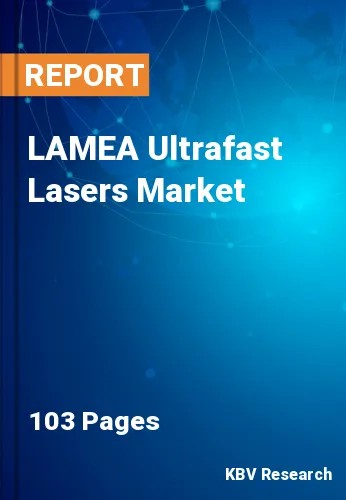The Latin America, Middle East and Africa Ultrafast Lasers Market would witness market growth of 20.2% CAGR during the forecast period (2022-2028).
The wavevector of the signal in 2D spectroscopy will be the sum of the three incident wavevectors employed in the pulse sequence. This is an example of a four-wave mixing experiment. There are multidimensional spectroscopies in the visible and infrared spectrums, as well as in combinations using several wavelength ranges. The majority of ultrafast imaging methods are variants of common pump-probe tests. Imaging with ultrafast electron pulses, terahertz imaging, electron diffraction imaging, and Kerr Gated Microscopy is a few frequently utilized methods. This is especially true in the biomedical field, where non-invasive, safe diagnostic methods are frequently sought after.
Recently, the skin's layers and tooth enamel deterioration have both been imaged using terahertz technology. Additionally, it has demonstrated the ability to effectively separate a breast cancerous zone from healthy tissue. A different method known as Serial Time-encoded amplified microscopy has demonstrated the ability to detect cancer cells in the blood in much smaller quantities and even sooner. There are several non-biomedical uses for ultrafast imaging, such as looking through or around opaque objects. After the pump has excited the sample, the sensor scans over delay times to provide a plot of intensity against time.
South Africa's ranking and standing in car production will greatly improve if it produces 1% of all vehicles, or 1,4 million vehicles annually, by 2035, according to the South African Automotive Masterplan (SAAM). As a result, the automotive sector is playing a very significant strategic and catalytic role in the South African economy as a whole, directly affecting many crucial economic policy goals such as GDP contribution, employment opportunities, skill development, economic relations, technology, and innovation.
The Brazil market dominated the LAMEA Ultrafast Lasers Market by Country in 2021, and would continue to be a dominant market till 2028; thereby, achieving a market value of $65.6 million by 2028. The Argentina market is experiencing a CAGR of 20.9% during (2022 - 2028). Additionally, The UAE market would display a CAGR of 19.9% during (2022 - 2028).
Based on Pulse Duration, the market is segmented into Femtosecond and Picosecond. Based on End User, the market is segmented into Medical, Industrial, Consumer Electronics, Automotive, Aerospace & Defense, and Others. Based on Type, the market is segmented into Fiber Lasers, Mode-Locked Lasers, Titanium-Sapphire Lasers, and Others. Based on Application, the market is segmented into Micromachining, Scientific Research, Medical Device Fabrication, Cardiovascular Stent Manufacturing, Bio-Imaging, and Others. Based on countries, the market is segmented into Brazil, Argentina, UAE, Saudi Arabia, South Africa, Nigeria, and Rest of LAMEA.
Free Valuable Insights: The Global Ultrafast Lasers Market is Predict to reach $3.7 Billion by 2028, at a CAGR of 15.3%
The market research report covers the analysis of key stake holders of the market. Key companies profiled in the report include Lumentum Holdings, Inc., NKT Photonics A/S (NKT A/S), TRUMPF GmbH + Co. KG, Coherent, Inc.(II-VI Incorporated), IMRA America, Inc. (Aisin Corporation), Amplitude Systemes, Clark-MXR, Inc., DPSS Lasers Inc., and Wuhan Huaray Precision Laser Co., Ltd.
By Pulse Duration
By End User
By Type
By Application
By Country
Our team of dedicated experts can provide you with attractive expansion opportunities for your business.

